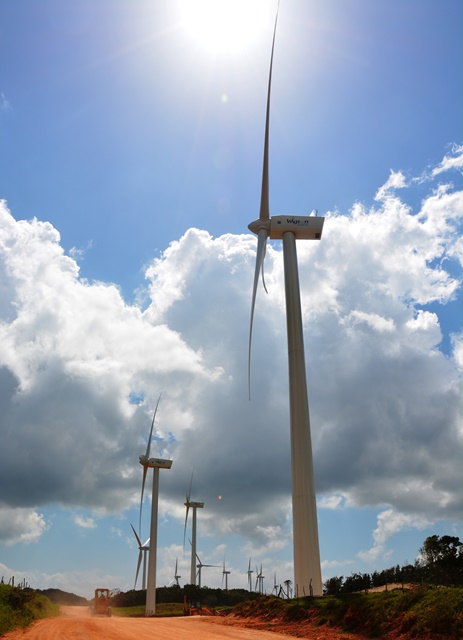
 Located in the central part of the country—in a semi-rural area called Rose Hill, in Manchester parish—the Wigton facility consists of three plants with a combined capacity of nearly 63 megawatts (MW). The first plant (20.7 MW) began operating in 2004, the second (18 MW) in 2010, and the most recent (24 MW) in 2016.
Located in the central part of the country—in a semi-rural area called Rose Hill, in Manchester parish—the Wigton facility consists of three plants with a combined capacity of nearly 63 megawatts (MW). The first plant (20.7 MW) began operating in 2004, the second (18 MW) in 2010, and the most recent (24 MW) in 2016.
Together they account for more than 6 percent of the country’s installed capacity for electricity generation and provide power to nearly 87,000 homes, according to Wigton Project Manager Michelle Chin Lenn.
While the northeast trade winds blow steadily most of the year, she said, they reach peak speeds in June and July. For Wigton’s turbines to reach maximum capacity, the wind needs to be blowing at 17 meters per second (equivalent to 38 miles per hour/61 kilometers per hour). Wind now accounts for just over 10 percent of Jamaica’s total installed capacity and about 8 percent of the energy used.
One sign that wind may be picking up speed in Jamaica: In 2016 the Virgin Group, headed by international investor Richard Branson, bought BMR Energy, which has a 36 MW plant at Potsdam, Malvern, in the Santa Cruz Mountains. It is the country’s largest private sector renewable energy project.
Wigton Windfarms, for its part, is a subsidiary of the Petroleum Corporation of Jamaica, a public company which—despite its name—has a broad mandate to manage all the country’s energy needs in a way that supports the overall national development strategy.
Increasing the share of renewable sources in the energy mix is a key part of that strategy. Last month, Prime Minister Andrew Holness said that the country was on track to be able to supply 30 percent of its electricity needs from renewable energy by 2030, which would be about double the share of renewables today. He noted that the planned increase in renewables would help protect the country against potential swings in oil prices.
“That would ensure that Jamaica has a real energy security,” he said. “The best way to ensure against volatility is to have your energy being locally generated and it is best when it is generated by the God-given natural resources,” Holness said, according to a press release from the Office of the Prime Minister.
Jamaica’s power grid is still heavily dependent on imported fossil fuels, and even though international oil prices are considerably lower now than they were a few years ago, electricity is still expensive compared to what it costs in the United States or Europe. The high prices, combined with declining prices for renewable technologies, are helping to drive more interest in renewable energy, according to Michelle Chin Lenn.
“Now you hardly pass a business that doesn’t have solar or is thinking of getting solar,” she said in a phone interview.
In addition to producing wind power, Wigton is doing its part to raise awareness about the importance of clean energy. While it has been providing some training for more than seven years, it expanded that effort when it opened the Wigton Renewable Energy Training Laboratory in November 2016.
The lab has a solar roof and training equipment to cover a wide range of courses. Topics include wind energy, of course, but also solar photovoltaics, fuel cells, small hydro, bioenergy, energy conservation, and others.
The lab collaborates with different educational institutions—both the University of the West Indies and the University of Technology, Jamaica have conducted practical exercises there for renewable energy courses—but it also offers classes to the public. In April, for example, it is offering a week-long training course: “Introduction to Solar Energy and Technologies, Building Assessments and Energy Audits.”
Eventually, the Wigton Renewable Energy Training Laboratory hopes to draw more students from other Caribbean countries. Since it opened, participants have ranged from do-it-yourselfers looking into renewable energy systems for themselves to bank loan officers who want to better understand the technology so that they can decide whether to offer loans.
Access to finance for renewables can be a challenge, whether for governments or for individuals, Chin Lenn said. “People want renewables,” she said. “They may not have access to the financing.”
 View Map
View Map